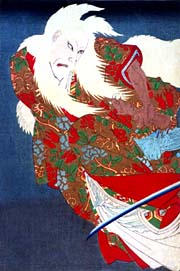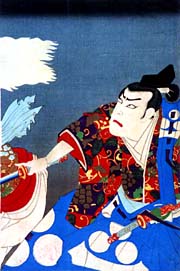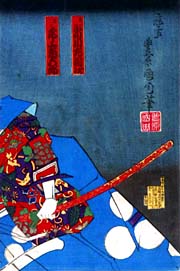| IBARAKI |
| Dance title | Ibaraki |
| Authors | Kawatake Mokuami (lyrics) Kineya Sh˘jir˘ III (music) Hanayagi Jusuke I (choreography) |
| History |
The dance-drama "Ibaraki" was premiered in April 1883 at the Shintomiza [casting]. Another dance-drama, "Modoribashi", created in 1890, is considered as the "first part" of "Ibaraki". The story is based on the legend of Ibaraki D˘ji, the infamous demon who dwelt at Rash˘mon gate by T˘ji temple in Ky˘to. A valiant retainer of Lord Minamoto Raik˘ named Watanabe no Tsuna was sent to defeat the demon but, after a fierce battle, he only managed to cut off the demon's left arm. When he took this back, the Imperial soothsayer predicted that the demon would return to reclaim its limb within seven days and nights, and therefore Tsuna was to lock both it and himself away in his mansion, observing strict abstinence and reciting prayers (Paul M. Griffith). |
| Key words |
Matsubamemono Minamoto Yorimitsu Nagauta Raik˘ Shinko Engeki Jűsshu Shitenn˘ Shitenn˘mono Shosagoto Watanabe Tsuna |
| Summary |
While Tsuna is isolated inside his mansion, his elderly aunt called Mashiba arrives. She has not seen him for many years and has travelled all the way from the distant province of Tsu to visit him. When she reaches his front gate, however, she is told she may not enter. Taken aback at this seemingly harsh treatment, Mashiba recalls how she looked after Tsuna as a child, caring for him as a true parent. Upon hearing her words the guilt-racked Tsuna relents and allows her inside. Taking up the seat of honour, Mashiba is offered refreshments and is then requested to dance by way of celebration of her nephew's brave exploits. This is the great highlight of the first part of the work. As the lyrics move through the four seasons, they describe Mashiba's own past growing up by the seashore and playing on the beach. Spring gives way to summer and, as Mashiba matured, she fell in love and married. But the union was fated not to last for soon the cool winds of autumn would blow the dew from the flowers and her husband passed away. The grasses withered in the winter's cold and she was left alone to guard the vacant shores. After her performance, Mashiba asks her nephew to tell how he fought with the demon, at which Tsuna relates what happened in dance form. Her curiosity aroused, Mashiba would like to see the severed arm. Suspecting nothing, Tsuna agrees to show it to her, even instructing his men to leave the room to stand guard outside. When she looks down at the limb the lyrics describe Mashiba's complexion gradually changing. Suddenly, she grabs it and dashes out, revealing that she is in fact the demon in disguise. Tsuna makes chase. After a brief musical interlude, the demon re-enters in its true form in splendid costume and kumadori make-up. Tsuna again battles with the evil ogre but cannot get the better of her supernatural powers. She escapes and Tsuna strikes a famous pose expressing his frustration as the curtain is closed. Now alone on the hanamichi pathway, the infamous demon of Ibaraki gloats before making her leaping ropp˘ exit as though flying away through the air. Courtesy of Paul M. Griffith |
| Trivia |
"Ibaraki" belongs to a category of works called matsubamemono, performed on a stage with a pine tree backdrop copying that of the N˘ theatre but, unusually, this dance is not based on any play in the N˘ repertoire. Rather, it is the Nagauta piece "Tsuna Yakata", "Tsuna's Mansion", that inspired the creation of "Ibaraki" (Paul M. Griffith). |
 |
 |
 |
|
Onoe Kikugor˘ V and Ichikawa Sadanji I playing the role of Ibaraki and Watanabe Genji Tsuna in the dance-drama "Ibaraki", which was staged in April 1883 at the Shintomiza (print made by Toyohara Kunichika) |
||
|
|
| Contact | Main | Top | Updates | Actors | Plays | Playwrights | Programs | Links | FAQ | Glossary | Chronology | Illustrations | Prints | Characters | Derivatives | Theaters | Coming soon | News |